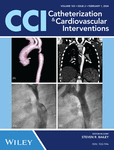Journal list menu
Export Citations
Download PDFs
ISSUE INFORMATION
CORONARY ARTERY DISEASE
ORIGINAL ARTICLES - CLINICAL SCIENCE
Index of Microcirculatory Resistance to predict microvascular obstruction in STEMI: A systematic review and meta-analysis
- Pages: 249-259
- First Published: 05 January 2024
Prognostic impact of in-stent restenosis in normal weight, overweight, and obese patients undergoing percutaneous coronary intervention
- Pages: 260-267
- First Published: 03 January 2024
Updated CRUSADE score to predict in-hospital bleeding: External validation in the Thai percutaneous coronary intervention registry
- Pages: 268-275
- First Published: 14 January 2024
Long-term outcomes after coronary intervention with biodegradable polymer stents in patients with acute coronary syndromes
- Pages: 276-285
- First Published: 13 December 2023
Higher 1-year mortality on rest days in patients with acute coronary syndromes and decompensated heart failure—A SPUM-ACS sub-study
- Pages: 286-294
- First Published: 25 December 2023
REVIEW
Review of intravascular lithotripsy for treating coronary, peripheral artery, and valve calcifications
- Pages: 295-307
- First Published: 13 December 2023
PEDIATRIC AND CONGENITAL HEART DISEASE
ORIGINAL ARTICLE - CLINICAL SCIENCE
Balloon atrial septostomy for transposition of the great arteries: Safety and experience with the Z-5 balloon catheter
- Pages: 308-316
- First Published: 13 December 2023
CASE REPORTS
Endoleak in covered CP stent causes procedural failure during transcatheter closure of sinus venosus defects
- Pages: 317-321
- First Published: 20 December 2023
Intra-stent aortic wall aneurysm formation after Be-graft covered stent implant
- Pages: 322-325
- First Published: 13 December 2023
CLINICAL MANAGEMENT
Introduction of transcatheter edge-to-edge repair in patients with congenital heart disease at a children's hospital
- Pages: 326-334
- First Published: 27 December 2023
What is Known: Atrioventricular valve regurgitation (AVVR) is a devastating complication in children and young adults with congenital heart disease (CHD), particularly in patients with single ventricle physiology. Transcatheter edge-to-edge repair (TEER) is a rapidly expanding, minimally invasive option for the treatment of AVVR that avoids the morbidity and mortality associated with open heart surgery. AVVR in CHD patients is a complex problem. An organized approach is required if the potential of TEER therapy is ever to be realized in this heterogenous population. What is New: We demonstrate an image-derived modeling protocol and clinically successful application of TEER in four patients with CHD including three patients with palliated single ventricle physiology and a Fontan circulation. What is Next: The protocolized approach to TEER in CHD described in this report may serve as a foundation for the safe initiation of TEER therapy at other free-standing pediatric hospitals. Further collaborative investigations of the use of TEER in this challenging population are warranted. Ideally, a multicenter study will ensue.
PERIPHERAL VASCULAR DISEASE
CASE REPORT
JETWING technique: Combination therapy of JETSTREAMⓇ and aggressive wire recanalization in calcified atheroma and dilatation technique for eccentric heavy calcified plaques using WINGMAN for insertion of protection wire
- Pages: 335-339
- First Published: 13 December 2023
VALVULAR AND STRUCTURAL HEART DISEASES
ORIGINAL ARTICLES - CLINICAL SCIENCE
Transcatheter edge-to-edge mitral valve repair for mitral regurgitation in patients with cardiogenic shock: A systematic review and meta-analysis
- Pages: 340-347
- First Published: 29 December 2023
Catheter-based therapy for intermediate or high-risk pulmonary embolism is associated with lower in-hospital mortality in patients with cancer: Insights from the National Inpatient Sample
- Pages: 348-358
- First Published: 23 November 2023
Five-year follow-up after percutaneous pulmonary valve implantation using the Venus P-valve system for patients with pulmonary regurgitation and an enlarged native right ventricular outflow tract
- Pages: 359-366
- First Published: 06 December 2023
Right ventricular remodeling and clinical outcomes following transcatheter tricuspid valve intervention
- Pages: 367-375
- First Published: 27 October 2023
Sex-based differences in left ventricular assist device clinical outcomes
- Pages: 376-381
- First Published: 23 October 2023
ORIGINAL ARTICLE - BASIC SCIENCE
CORONARY ARTERY DISEASE
COMMENTARY
Percutaneous coronary intervention: Before, after, or during TAVR?
- Pages: 389-390
- First Published: 22 December 2023
-
Decisions surrounding if, and when, to perform coronary revascularization in patients undergoing trans-catheter aortic valve replacement (TAVR) are often complex.
-
Concomitant percutaneous coronary interventions (PCI) and TAVR is associated with comparable technical success, but higher rates of bleeding and acute kidney injury, compared to staged procedures or no PCI.
-
Timing of PCI relative to TAVR should be individualized based on clinical status, lesion complexity and anticipated risks of bleeding and renal injury.





